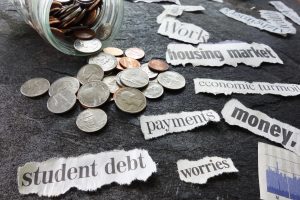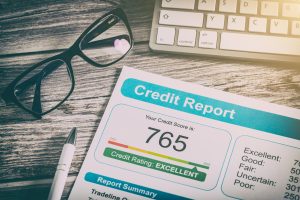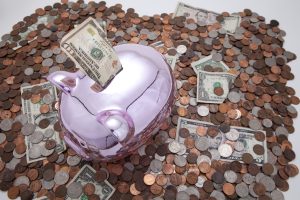
by Suzanne Holloway | Nov 21, 2025
Debt is money you owe to a person or business. While debt often carries a negative connotation, responsible borrowing and repayment can improve your credit history.
Debt & Credit
Debt becomes a problem when you can’t repay what you owe. Missed minimum payments, carrying high credit card balances, or skipping payments can all damage your credit. For more information about credit and credit history, you can read this previous blog.
Budgeting & Mindful Spending
Being thoughtful about spending and borrowing can help you avoid unnecessary debt and improve your financial well-being. Financial well-being means having control over your money and the ability to make choices that reflect your goals and values. It starts with planning, spending less than you earn, and setting aside savings each month, usually with the help of a budget.
Mindful spending is about making intentional choices, aligning your purchases with your personal goals instead of spending out of habit. This awareness can reveal habits that you may want to adjust to save more. Practicing mindful spending not only helps you spot areas to cut back but also reduces financial stress. When you have a plan and track your money, you gain more control, security, and peace of mind. To learn more about budgeting, click here.
Getting Out of Debt

© zimmytws / Adobe Stock
The first step to getting out of debt is creating a realistic budget. You might also look for ways to increase your income, such as finding a higher-paying job, taking on a side gig, or selling unused items. If you’re struggling to keep up, reach out to your creditors to discuss a new payment plan.
Debt Collection
A debt collector is an individual or company, like a collection agency or a law firm, that collects debts on behalf of others or for themselves after purchasing past-due accounts. If you’re contacted by a debt collector, speak with them at least once to gather information and confirm whether the debt is truly yours—but avoid sharing sensitive details unless you’re sure of their legitimacy, as scammers often pose as collectors. By law, debt collectors must tell you the exact amount you owe, the creditor’s name, how to obtain details about the original creditor, and what to do if you believe the debt isn’t yours.
Debt collectors have a limited time to sue you for unpaid debts—this “statute of limitations” starts after your first missed payment. Once expired, the debt becomes “time-barred,” and collectors can no longer sue or threaten to sue for payment. However, in some states, making a payment or acknowledging the debt can restart the statute of limitations, so proceed carefully.
If you would like a debt collector to stop contacting you immediately, send a letter by certified mail and ask for a return receipt. If a collector threatens you, hang up and report them to the Federal Trade Commission (FTC).
Debt Elimination Tools & Resources
A reputable credit counseling organization can help by offering expert advice on managing money and debts, developing a budget and a realistic debt repayment plan, and providing free educational materials and workshops. Most reputable counseling organizations are non-profits or universities, such as UF/IFAS Extension, that offer services in person, online, or by phone for little to no fee. Other available resources, such as mobile apps and online tools, include:
An Equal Opportunity Institution.

by Suzanne Holloway | Nov 21, 2025
When people talk about credit, they are referring to their credit history. Credit history describes how they have used money over time, which can significantly impact many aspects of life, including housing, employment, and finances, because landlords, lenders, insurance companies, and potential employers often review it when making decisions.
Three nationwide credit bureaus—TransUnion, Equifax, and Experian—collect credit history and additional information about individuals, such as names, addresses, Social Security numbers, credit cards, loans, and outstanding debts.
Credit Reports

© REDPIXEL / Adobe Stock
Credit bureaus provide credit reports to businesses that pay for this information to assess your reliability before working with you, like renting you an apartment or giving you a credit card. Whether your credit is considered “good” or “bad” depends on your history. People who pay bills on time and don’t borrow more than they can repay tend to have good credit, while those with late payments or debts they can’t afford may develop bad credit.
Each bureau gathers data from different sources, so your credit reports may vary slightly between them. Nonetheless, all three bureaus strive to keep their information accurate, but mistakes do happen, and checking your credit report for errors is important because inaccuracies can affect your opportunities. Accessing your credit report can also help spot signs of identity theft. You can order a free annual credit report from a centralized provider. To order your report, these are your options:
If you find errors in your report, you have the right to dispute them and seek corrections.
Credit Scores
A credit score is a number, usually between 300 and 850, that helps predict the likelihood and timeliness of loan repayment and other payments. Lenders, landlords, and other businesses use your credit score to decide whether to offer you credit and what terms, such as interest rates, you’ll receive.
In general, a higher score shows you have “good” credit, making you a lower financial risk, while a lower score signals “bad” credit, which can make it harder to get approved or result in higher interest rates. Credit scores are grouped into five ranges: poor (300–579), fair (580–669), good (670–739), very good (740–799), and exceptional (800–850). About 71% of Americans have a good FICO score or better. You can improve your credit score over time with consistent effort; it’s entirely possible.
Credit scoring systems are calculated in different ways. Most lenders use the Fair Isaac Corporation (FICO) score, which is based on five categories: payment history (35%), amounts owed (30%), length of credit history (15%), new credit (10%), and credit mix (10%).
Credit Tools & Resources
Unlike credit reports, you usually have to pay to see your official credit score, although some mobile apps now offer it for free.
- Experian offers a free FICO 8 credit score, credit report, credit monitoring alerts, dark web surveillance, and a privacy scan, with additional features available on paid plans.
- Credit Karma provides free daily credit reports and VantageScores from Equifax and TransUnion, credit analysis and tips, and basic identity monitoring.
- Credit Sesame gives free daily VantageScore updates from TransUnion, insights into key credit factors, and a score simulator, with more features on paid plans.
Furthermore, some financial institutions also let you see your score; always verify whether any credit monitoring fees apply.
Additional Resources
Getting a Credit Card (FTC)
An Equal Opportunity Institution.

by Samantha Kennedy | Oct 24, 2025

Taking the time to identify and plug spending leaks can help reduce stress and improve overall financial health. (Photo source: Adobe Stock)
When it comes to managing money, most people focus on the big-ticket items: rent or mortgage, car payments, or student loans. But it is often the small, unnoticed expenses – known as spending leaks – that can really make a big impact on overall financial health. These leaks may seem harmless on their own, but over time, they can add up to hundreds or even thousands of dollars lost each year.
What Are Spending Leaks?
Spending leaks are recurring or impulsive purchases that do not add significant value to your life but slowly drain your budget. Think of them as the financial equivalent of a dripping faucet – barely noticeable at first, but potentially becoming a flood over time. Common culprits include daily coffee runs, unused subscriptions (magazines, streaming services, etc.), frequent takeout, ATM fees, and impulse buys.
Costly Coffee
One of the most cited examples of a spending leak is the daily coffee habit. Spending $6-8 a day on specialty drinks may not seem like much, but over a year, that could add up to nearly $3,000. Brewing coffee at home or switching to a more affordable option can plug this leak without sacrificing your morning ritual.
Surplus Subscriptions
Streaming services, fitness apps, cloud storage, and digital magazines: many people are subscribed to more services than they actually use. According to a survey by Variety magazine, Americans spend an average of $69 a month on subscriptions, and many of those subscribers often lose track of all they are paying for. The same thing goes for magazine subscriptions. It is so easy to let those build up. Reviewing subscriptions quarterly and canceling unused ones can free up significant cash.
Expensive Eats
Grabbing lunch at work or ordering dinner a few times a week might feel like a convenience, but it is a major leak. Preparing meals at home – even just a few more times a week than you currently do – can save hundreds of dollars a month. Even with the higher cost of groceries, meal prepping and planning ahead can make home cooking more manageable and cost-effective. Frequent use of meal delivery apps is also an easy way to spend more than necessary on meals.
Convenience Costs
Using out-of-network ATMs or paying for convenience fees when paying bills online can seem minor, but they add up. Opt for fee-free banking options whenever possible, and plan ahead to avoid unnecessary charges. Even small fees of $2–$5 per transaction can total over $100 annually. Overspending can also lead to expensive late fees, overlimit fees, and overdraft fees.
Bargain Buys
Retailers are masters at encouraging unnecessary purchases – whether it is a tempting display at checkout or a flash sale online. One way to combat this is by implementing a 24-hour rule: wait a day before making any non-essential purchase. This simple habit can help you avoid buyer’s remorse and keep your budget intact. Even if something seems like a bargain, it is still a waste of money if it is something you do not need.
Spending leaks are sneaky, but they are also fixable. By identifying and addressing these small, recurring expenses, you can take control of your finances without making drastic lifestyle changes. A few mindful adjustments can lead to big savings—and a healthier financial future.
For more information about this and other money management topics, please call your local Family & Consumer Sciences (FCS) agent. You can find your nearest Florida FCS agent here.
An Equal Opportunity Institution.

by Suzanne Holloway | Oct 24, 2025
We’ve covered budgeting and saving as foundations of money management. Investing is another element: it means putting money into assets like stocks, bonds, or real estate to earn returns through capital gains, dividends, or interest.
Investing involves more risk than saving; your money is not federally insured, and you could lose the amount you deposited. That’s why, before investing, it’s crucial to have an emergency fund covering three to six months of expenses and to keep money for short-term needs—like a car or home down payment—safe and easily accessible in an insured bank or credit union account.
If you’re new to investing, consulting a qualified professional, such as a financial adviser, can help you build a strategy aligned with your goals. While investing carries greater risk than saving, it also offers the potential for larger long-term rewards.
Investment Products
The most common investment products are stocks, bonds, mutual funds, and exchange-traded products, often used for retirement or college savings. Other vehicles include real estate, precious metals, commodities, private equity, and cryptocurrencies.

© Freedomz / Adobe Stock
- Bonds are like IOUs commonly issued by governments, municipalities, or corporations to raise money. Investors who buy bonds lend money and receive interest over a specified period. Main types include corporate bonds, municipal bonds, and U.S. Treasuries securities.
- Stocks represent ownership in a company, or “equity.” Stocks come in two main forms: common stock and preferred stock.
- Mutual funds pool money from many investors and invest in a diversified mix of assets, such as stocks, bonds, and money market instruments. The overall mix is called the fund’s portfolio, and a professional adviser manages it. Exchange-traded products (ETPs), including exchange-traded funds (ETFs), combine aspects of mutual funds and conventional stocks.
- Hedge funds are private, unregistered investment funds that use pooled investor money to pursue more flexible investments and strategies.
- Commodities are basic goods and materials like precious metals, crude oil and natural gas, wheat, coffee, and livestock.
- Cryptocurrencies, or crypto assets, are digital assets built on blockchain technology.
Always research the risks, fees, and suitability of any investment before committing your money.
Investment Accounts
Investment accounts are used to hold your assets and cash. The right type depends on your goals, risk tolerance, and ownership needs.
- Brokerage accounts let you buy and sell stocks, bonds, and other types of investments. You can open a cash account (pay in full for purchases) or a margin account (borrow to invest).
- ABLE accounts, or 529A accounts (enabled by the 2014 Achieving a Better Life Experience Act), allow individuals with disabilities to save and invest with tax advantages, without risking eligibility for public benefits.
- College Savings accounts, like 529 plans and Coverdell ESAs, help parents or guardians invest in education expenses. Similar to college savings accounts, custodial accounts, established under the Uniform Gifts to Minors Act (UGMA) or Uniform Transfers to Minors Act (UTMA), allow adults to invest for a child’s benefit.
- Saving for retirement may be the most important financial goal you’ll ever pursue. Building a nest egg of enough funds that can support you for twenty years or more requires proactive planning, steady saving, and disciplined investing. Common retirement accounts include 401K, 403(b) and 457(b), and Individual Retirement Accounts (IRAs).
Most financial institutions offer at least standard brokerage accounts and IRAs, and some may also provide college savings accounts and custodial accounts.
Investment Management
Investment management is the professional oversight of your investment portfolio. This service, also known as asset management, can be provided in different ways. Traditional investment advisors offer personalized guidance, helping you build and maintain a portfolio tailored to your financial goals. Alternatively, a “robo-advisor” refers to an automated digital investment advisory program; it creates and manages a portfolio for you, based on your goals and risk tolerance after answering an online questionnaire, often at a lower cost.
Investment Scams
Investment scams promise quick, easy money with little to no risk, often through financial markets, cryptocurrency, real estate, or precious metals/coins. These scammers attract you with infomercials, social media posts, or online ads that encourage you to attend a free seminar/training, order free materials, or watch free introductory videos learning about the secret of getting rich quickly.
- Investment training scams: Their “tested” or “secret” strategy will help you get rich and change your life, but these promises and so-called success stories are almost always fake or rare exceptions.
- Real estate investment scams may advertise “world-class” properties with luxury amenities, but these properties often take years to materialize, are never built, or lack the promised features. Reselling the land may also be impossible due to a lack of buyers.
- Real estate training scams market online or in-person programs by promising risk-free investments and quick profits with little effort or experience—claims that are rarely true and are designed to get you to pay for their courses.
- Precious metals and coin scams often feature individuals posing as “metal dealers” or “rare coin merchants” who gain your trust, falsely claim expertise, and then fail to deliver on their promises, pocketing your money. Before investing in bullion, coins, or precious metals, review the Commodity Futures Trading Commission’s (CFTC) precious metals fraud alert and research the market carefully.
- Cryptocurrency investment scammers often target victims via social media, texting, or dating apps, building trust through fake connections, then pitch fraudulent crypto investments. Cryptocurrency scammers will use fraudulent investment platforms and will often appear very lucrative, encouraging the victim to continue to invest; however, when they are ready to withdraw all their earnings, their account is usually “frozen” with “fees” needed to pay to unlock the funds. If you were a target of a cryptocurrency scam, you can file a complaint with the Internet Crime Complaint Center (IC3).
Red flags include guarantees of high returns, pressure to act fast, scarce investment details, or promises of wealth with little effort or risk. Always research independently before making decisions, resist pressure, and know the risks involved in investing. If you believe you have been a victim of fraud, report it to the Federal Trade Commission (FTC) or the U.S. Securities and Exchange Commission (SEC).
Investment Tools & Resources
There are many investing resources available, including apps, online tools, and real-life professionals. Some popular investment apps include:
No matter which resource you choose, always take time to research your options, understand the risks, and select tools that match your goals and level of experience.
Additional Resources
A Roadmap to Your Journey to Financial Security (SEC)
Cost of Retirement (Khan Academy)
An Equal Opportunity Institution.

by Suzanne Holloway | Sep 26, 2025
In a previous blog, we explored budgeting as one of the elements of money management. But once you know where your money is going, the next step is making that money work for your future through saving.
Savings is the portion of your income set aside for future expenditures, whether it’s for emergencies, a down payment on a home, or retirement. In some cases, employers help with this through deferred compensation plans, which set aside part of your paycheck to be paid out later, often at retirement.
Most people have been told to follow the rule of saving 10–20% of their income, but that isn’t always realistic. Instead of getting discouraged, create a savings rule that works for your circumstances. Focus first on building your emergency fund and choose to save an amount—either a specific dollar figure or a percentage of your income—that feels manageable. The key is consistency. Even small, regular contributions add up over time and build the habit of saving. People who regularly track their expenses and savings often find themselves saving more, simply because they’re staying mindful and intentional about where their money goes.
Types of Saving Accounts

Save regularly toward your goals – it will add up quickly! Photo source: UF/IFAS Extension
Where should you keep your savings? The answer depends on your individual needs and the amount you have set aside. While piggy banks, jars, and other at-home containers can serve as temporary spots for small amounts, they aren’t secure for holding larger sums. Instead, consider moving your money to a depository like a bank, credit union, or another financial institution. These places not only offer services such as checking and savings accounts, loans, and investment options, but also keep your money safer: your funds can earn interest and are generally insured against loss from theft, fire, or other disasters—unlike the cash kept at home.
Keep in mind, not all savings accounts are the same. The right match(es) for you depend(s) on your financial goals, how easily you want to access your money, the interest rate, and any account fees or restrictions.
- Traditional savings accounts are common, easy to open, and generally fee-free, but they tend to offer low interest rates. Most brick-and-mortar banks and credit unions offer traditional accounts, often paired with convenient mobile apps.
- Student and kids’ savings accounts—available at many brick-and-mortar banks and credit unions—are specifically designed to help children, teens, and students (often up to age 25) build good financial habits, like budgeting and saving.
- A Health Savings Account (HSA) is a specialized savings account you can use to save for qualified out-of-pocket medical expenses, offering both tax incentives and flexibility for healthcare needs.
- High-yield savings accounts provide above-average interest rates (or APY). These are typically found at online banks, which can offer better rates and lower fees due to reduced operating costs. Some financial institutions also offer high-yield checking account options.
- Money market accounts blend features of both checking and savings. They earn interest, but also let you make limited withdrawals or debit purchases each month, making them a flexible but somewhat restricted option.
- Certificates of deposit (CDs) let you lock in your money for a fixed period, usually at a higher interest rate than standard savings. Early withdrawals are often penalized.
- Cash management accounts are a middle ground between saving and investing. These interest-bearing accounts securely hold your money while you decide on your next investment move.
By choosing the right account(s) based on your financial goals, you can make your money work smarter, not just harder.
Savings Tools & Resources
Generally speaking, most savings apps are also built into budgeting apps—something we covered in a previous blog—or are included with investment apps, which we’ll explore in an upcoming post.
Additional Resources
Save and Invest (MyMoney.gov)
Saving & Investing (Khan Academy)
An Equal Opportunity Institution.

by Suzanne Holloway | Sep 5, 2025
Money management refers to the process of overseeing and planning all aspects of your finances, including budgeting, saving, and investing. Effective money management helps you understand your current financial situation, set goals for the future, and make informed decisions to support your financial and overall well-being.
What’s a Budget?
Many people view budgeting, or “living on a budget,” as restrictive, but in reality, it is simply a tool that summarizes your income and expenses over a set period—often a month—to help you prioritize spending and achieve your goals. To start, calculate your total income from paychecks and any other sources (for example, child support, gifts, or public assistance). Then, list all your fixed costs (e.g., rent, insurance, property taxes, and occasional fees) and flexible expenses (e.g., groceries, transportation, and entertainment). By managing your flexible expenses wisely, you can ensure you have enough to cover your fixed obligations and also make progress toward your financial goals. Subtract total expenses from your income. If the result is negative, you are spending more than you earn and may need to adjust your budget. At the start of each budgeting period, set your plan, and at the end, review your spending and adjust as needed for the next period.
Budgeting Strategies
A budget isn’t one-size-fits-all, because everyone’s income, expenses, and priorities are different. Budgets should be tailored to your unique situation, which is why there are various strategies to choose from. Some of the most common strategies include the 50/30/20, Pay Yourself First, Zero-based, and Envelope budgets.
The 50/30/20 method divides your income into three categories: 50% for needs like housing, insurance, and groceries—things you can’t do without; 30% for wants such as dining out, subscriptions, or vacations; and 20% for savings to support future goals like building an emergency fund, buying a home, or saving for retirement. Debt reduction, such as paying minimum and additional payments for loans and credits, is placed in both the needs and savings categories.

© Andrey Popov / Adobe Stock
Pay Yourself First sets savings as the first expense by setting aside a fixed amount or percentage of your income as soon as you are paid. Start by focusing on building your emergency fund until it covers three to six months of essential living expenses. Once that’s accomplished, you can direct savings toward other financial goals. Setting up separate accounts or vaults for each goal can make it easier to track your progress and stay organized.
Zero-Based Budget ensures that every dollar you earn is assigned a specific purpose—whether for expenses and savings—so that your income minus your expenses always equals zero.
Envelope Budget, sometimes called “cash stuffing,” involves dividing your funds into envelopes (physical or digital), each representing a spending category. When the money in an envelope runs out, you stop spending in that category until the next budgeting period.
Budgeting Tools & Resources
There are many budgeting resources available, including apps, online tools, and printable worksheets. While some are free, many charge a fee to use or require payment to unlock additional features such as detailed reports, automatic account syncing, or advanced goal-tracking tools. Popular free mobile applications include:
*basic version; paid premium features available
Common paid apps:
Some banks and credit unions also offer built-in budgeting tools—check if there are any fees. Free printable worksheets from organizations like the Federal Trade Commission’s budget worksheet and the UF/IFAS Extension Money Management Calendar are also available. Furthermore, some prefer to create their budgets or use templates in Google Sheets or Microsoft Excel.
Explore different tools and mobile application options. Consider your financial goals, resources, and preferred budgeting strategy before making a decision, especially if you are considering a paid service.
Additional Resources
50/30/20 Calculator (OPERS)
An Equal Opportunity Institution.










